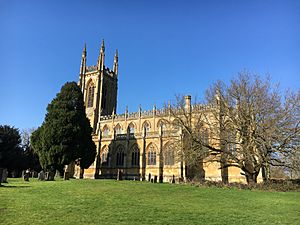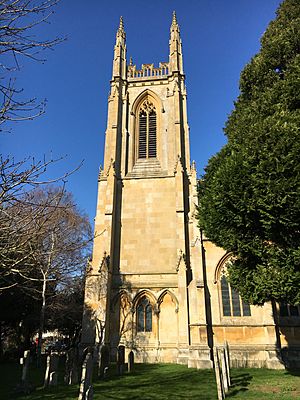St Peter ad Vincula Church, Hampton Lucy facts for kids
Quick facts for kids St Peter ad Vincula, Hampton Lucy |
|
|---|---|

A view of St Peter ad Vincula Church from the south-east
|
|
| 52°12′39″N 1°37′34″W / 52.21076°N 1.62608°W | |
| OS grid reference | SP2564757013 |
| Location | Hampton Lucy, Warwickshire |
| Country | England |
| Language(s) | English |
| Denomination | Church of England |
| Architecture | |
| Heritage designation | Grade I listed |
| Designated | 5 April 1967 |
| Architect(s) | Thomas Rickman and Henry Hutchinson |
| Style | Gothic Revival |
| Years built | 1822–1826 |
| Completed | 1826 |
| Administration | |
| Parish | Hampton Lucy |
| Benefice | Hampton Lucy with Charlecote and Loxley |
| Deanery | Fosse |
| Archdeaconry | Warwick |
| Diocese | Diocese of Coventry |
St Peter ad Vincula is a historic Church of England church in Hampton Lucy, Warwickshire. It is considered a very important building, known as a Grade I listed site. This means it has special historical or architectural value. The church was built in the 1820s, replacing a much older church from the Middle Ages.
History of the Church
The original medieval church of St Peter stood near where the current church is today. In 1822, the old church was taken down. The Lucy family from Charlecote Park decided to build a new one. They hired two famous architects, Thomas Rickman and Henry Hutchinson. They designed the new church in the Gothic Revival style. This style brought back the look of medieval Gothic buildings.
The first part of the church built was the main hall, called the nave, and the tower. These parts were made from smooth limestone blocks. The nave has six sections with walkways on the north and south sides. The outside walls have a decorative base. The window frames, roof edges, and pointed gables are all beautifully carved. The tower has three levels. It ends with eight-sided spires and a decorative, crenellated top with openings.
In 1858, another famous architect, Sir George Gilbert Scott, added more parts. He designed the chancel (the area around the altar) and a north entrance porch. These new parts were also richly decorated in the Gothic Revival style. Above the north porch, there is a statue of St Peter holding chains. You can also see the Lucy family's coat of arms there.
The large stained glass window at the east end shows scenes from the life of St Peter. This window was fixed after it was damaged during the Second World War. An American airplane crashed nearby, causing some damage. The church was officially given its Grade I listed status on April 5, 1967. This was because it is a "very good example" of 19th-century church design. The only parts left from the original medieval church are two groups of tiles on the floor of the south aisle. These tiles show heraldic symbols and plant designs.
Church Bells
Today, there is only one bell in the tower of St Peter ad Vincula. This bell was made by Thomas Mears in 1826. It was meant to be the largest bell in a set of eight. However, the other bells and their frame were never added.
The old medieval church used to have five bells in its tower. These bells were made by Richard Keene in 1672–1673. This set of bells is now considered "lost." They were probably last rung in 1822 before the old church was torn down. The largest of these old bells weighed about 8 cwt, which is about 400 kilograms.
See also
- Holy Trinity Church, Coventry – another nearby historic church


